Many people believe survival gear has to cost a fortune. However, with the right research and a practical mindset, you can assemble effective cheap survival gear that prepares you for real emergencies. From harsh weather to unexpected disasters, basic tools often matter more than expensive branding. Therefore, if you focus on function over flash, you can build a reliable kit without draining your bank account.
Essential Categories of Cheap Survival Gear to Consider
When building a survival kit, you should begin by covering the basics: shelter, water, fire, food, and first aid. Each category offers affordable options that deliver performance without the price tag. For instance, a space blanket provides heat retention similar to expensive bivvy bags, and water purification tablets often work just as well as portable filters.
Why Camping Gear Gifts Make the Perfect Present for Outdoor Lovers
In addition, budget knives, plastic tarps, and reusable zip ties can all play crucial roles in survival situations. By identifying versatile, cost-effective tools, you can build a well-rounded kit that keeps you safe when it matters most.

Cheap Survival Gear That Covers the Big Five: Fire, Water, Shelter, Food, Safety
You don’t need brand-name products to meet core survival needs. In many cases, generic or lesser-known alternatives perform just as well. For example, ferro rods and waterproof matches provide reliable fire-starting abilities at a fraction of the cost of fancy lighters. Similarly, plastic water containers, combined with iodine tablets, create an effective hydration system on the cheap.
As for shelter, lightweight tarps or emergency tents offer solid protection from rain and wind. Food-wise, high-calorie ration bars or vacuum-sealed rice packs supply nutrition without breaking the bank. Most importantly, a basic first aid kit from your local pharmacy still helps treat cuts, burns, and other minor injuries effectively.
How to Build a Cheap Survival Gear Kit from Scratch
You can start building your survival kit today using items you already own. For instance, an old backpack becomes your carry system, while a flashlight from your garage covers lighting needs. Adding to that, dollar stores often sell compact tools, gloves, rope, and even compact cooking equipment that performs well in emergencies.
Atlas Survival Shelter Prices: A Comprehensive Guide
Additionally, bulk-buying essentials like batteries or instant meals can save significant money over time. Therefore, creating a practical and reliable setup becomes more about creativity and planning than big spending.

Mistakes to Avoid When Shopping for Cheap Survival Gear
Buying inexpensive gear doesn’t mean choosing the absolute cheapest option. In fact, focusing too much on price alone can backfire. For example, a $1 multitool may snap the first time you use it, leaving you vulnerable in critical moments. Instead, look for affordable gear with good reviews, basic warranties, or field-tested reputations.
Also, avoid buying unnecessary gadgets that overcomplicate your kit. Stick with tools that solve real problems. A simple, durable knife will always outperform a poorly made one with a dozen attachments. Quality matters—especially in survival.
Top Places to Find Affordable Gear That Performs
You can find dependable gear online, at local discount stores, or through military surplus shops. For instance, many online marketplaces offer buyer-rated products that combine value with proven effectiveness. In addition, checking clearance sections of sporting goods stores often reveals hidden gems.
Furthermore, thrift stores and garage sales sometimes have gear at a fraction of retail price. Just be sure to inspect items for damage before purchase. When shopping online, read reviews and pay attention to product specifications to avoid disappointment.
How Cheap Survival Gear Supports Long-Term Preparedness
Many people treat survival kits as one-time projects. However, long-term readiness means maintaining, upgrading, and rotating your gear. Thankfully, cheaper gear allows you to make regular updates without financial strain. For example, you can rotate food rations more often or test new items without risk.
Tactical Gear Storage Essentials for Professionals and Enthusiasts
In addition, low-cost duplicates let you keep backup gear in different locations: your home, car, workplace, or bug-out bag. This approach multiplies your preparedness without multiplying your expenses. As a result, you gain peace of mind on a budget.

How to Test Your Gear Before an Emergency Happens
Never assume that your gear works just because it’s new. Always test each item under controlled conditions. Practice setting up your tarp shelter, boiling water, or starting a fire with your ferro rod. This helps you build confidence and recognize weaknesses in your setup.
For example, you may find your flashlight has poor battery life, or your knife dulls quickly. By testing gear regularly, you learn how to use it effectively and spot replacements when needed. Consequently, your kit stays reliable—and so do you.
Upgrading Over Time Without Breaking the Bank
You can always start cheap and improve over time. Survival readiness isn’t about buying everything at once—it’s about building gradually. Perhaps you start with a plastic tarp but later upgrade to a lightweight nylon shelter. Similarly, your generic multitool might get replaced by a trusted brand when the budget allows.
Best Bug Out Bag: The Ultimate Guide for Emergency Preparedness
Meanwhile, your basic gear still offers protection and functionality while you wait. In the end, every improvement you make brings you closer to optimal preparedness, without financial shock.

Why Cheap Survival Gear Helps Beginners Get Started
Newcomers often feel intimidated by the price tags on premium survival kits. Fortunately, affordable options lower that barrier and encourage people to start preparing. A beginner with basic tools and strong knowledge often fares better than someone who overspends on high-end gear they don’t know how to use.
Moreover, cheap gear promotes experimentation. You can test setups, modify loadouts, and discover what works best for you—all without fear of wasting money. In addition, it invites families, students, and low-income individuals into the preparedness community, where knowledge and adaptability matter more than flashy tools.

